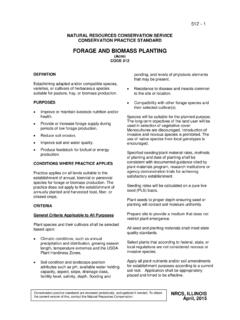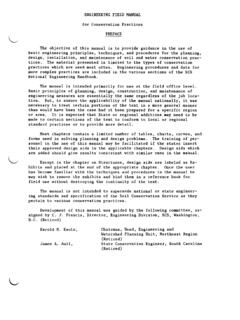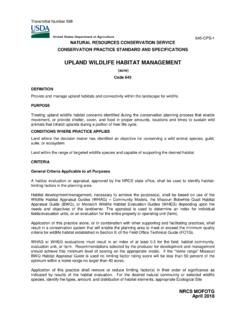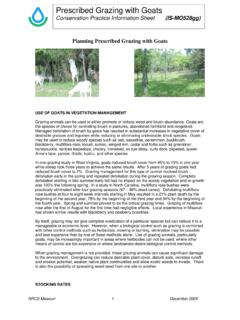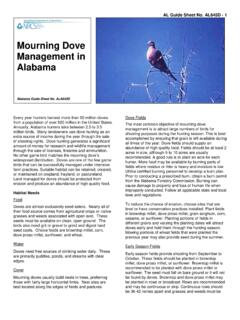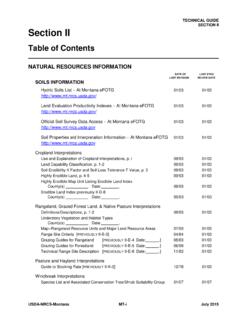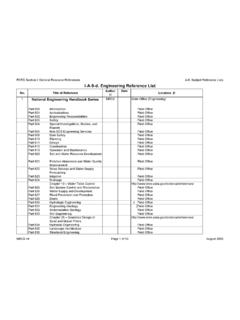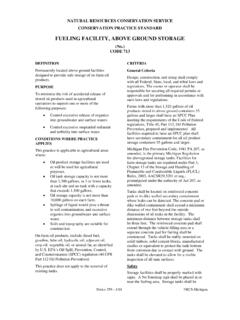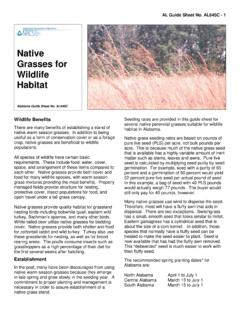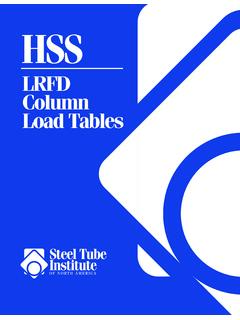Transcription of DESIGN GUIDE AL #1 BRIDGES FOR LIVESTOCK AND …
1 DESIGN GUIDE AL #1 BRIDGES FOR LIVESTOCK AND AGRICULTURAL EQUIPMENT CONSTRUCTION DETAILS AND SPECIFICATIONS Alabama (adopted from Maryland NRCS) May 2012 DESIGN GUIDE AL #1 Agricultural Bridge Crossings NRCS Engineering, Alabama May 2012 Page i TABLE OF CONTENTS SECTION PAGES I. General Information .. 1 General .. 1 DESIGN .. 1 Site Selection .. 2 Procedure .. 2 Materials .. 3 Decking Options .. 4 Decision Recording .. 4 Figure 1. Standard AASHTO Truck Loads .. 5 II. Sample Operation and Maintenance Plan .. 6 III.
2 Construction Specifications .. 7 IV. Beam Tables Table 1. LIVESTOCK Use Only (AL-ENG-578-001) and LIVESTOCK and Farm Equipment (AL-ENG-578-002) .. 10 Table 2. LIVESTOCK and Vehicular Loads (AL-ENG-578-003) .. 12 V. Construction Drawings for Agricultural BRIDGES Details: AL-ENG-578-001 Timber Bridge for LIVESTOCK Use Only (TB-1) .. 15 AL-ENG-578-002 Timber Bridge for LIVESTOCK and Farm Equipment (TB-2) .. 16 AL-ENG-578-003 Timber Bridge for LIVESTOCK and Vehicular Loads (TB-3) .. 17 VI. Construction Details for Agricultural Bridge Components Details: AL-ENG-578-004 Plate and Curb Attachment (TB-2D).
3 18 AL-ENG-578-005 Lateral Bracing and Bearing Pad (TB-3D) .. 19 AL-ENG-578-006 Alternate Detail for Bearing Pad and Lateral Bracing (TB-4D) .. 20 AL-ENG-578-007 Nail Laminated Deck (TB-5D) .. 21 AL-ENG-578-008 C-Clip (TB-6D) .. 22 AL-ENG-578-009 Details For Prestressed Concrete Bridge (PCB-1) .. 23 AL-ENG-578-010 Details for Prestressed Concrete Bridge (Safety Fence) (PCB-2) .. 24 AL-ENG-578-011 Prestressed Concrete Bridge Sequence of Construction (PCB-3) .. 25 DESIGN GUIDE AL #1 Agricultural Bridge Crossings NRCS Engineering, Alabama May 2012 Page 1 SECTION I GENERAL INFORMATION GENERAL This DESIGN GUIDE is a technical resource prepared by the Maryland NRCS Engineering staff, adopted for use in Alabama, and is intended for use by the NRCS in Alabama and its partners.
4 The bridge designs contained in this DESIGN GUIDE are offered as an alternative to other types of stream crossing such as fords and culverts. These prequalified designs are to be used as part of a site-specific DESIGN . Construction drawings for BRIDGES of various uses and sizes are included, as well as other appropriate construction details and specifications. The bridge designs contained in this DESIGN GUIDE are for on farm use only. Section II contains a general operation and maintenance plan for the BRIDGES . Section III contains the construction specifications to be used as part of the site-specific DESIGN .
5 These construction specifications are to be used for all bridge designs facilities. Add site specific construction specifications as needed. Section IV contains the beam selection tables to be used for the different uses as shown in the DESIGN GUIDE . Section V contains the appropriate construction drawings for the agricultural BRIDGES . Section VI contains construction details for the agricultural bridge components. To aid in the DESIGN process, the drawings, DESIGN GUIDE text and specifications are available on the Alabama Home Page. No changes are allowed on these details without prior approval from the NRCS engineering staff.
6 DESIGN Loading: Several different DESIGN loads were chosen for varying situations. For LIVESTOCK and tractor loads, 100 psf (unfactored) and 5000 lbs. per wheel (unfactored) respectively were utilized in the DESIGN of the beams. This information was taken from Midwest Plan Service, Structure and Environment Handbook, 11th Edition 1983 page Tandem wheel tractors and tandem axle trucks are not covered in this DESIGN GUIDE . In addition to the above designs, loadings for vehicle types 4 ton GVW, H10, H20 and 40 ton GVW have been included. See figure 1 for gross vehicle weights (GVW) and load distributions.
7 These loadings will cover such vehicles as lime and grain trucks. DESIGN Procedures: The DESIGN of the steel beams follows the procedures of the Manual of Steel Construction; load & Resistance Factor DESIGN 1st edition. load factors of and were used for dead load and live load factoring, respectively. The bridge is designed assuming one vehicle, moving at low speeds, is on the bridge or fully loaded with LIVESTOCK whichever yields the greatest load for the scenarios given. The DESIGN of the wooden deck follows the procedures of the Timber BRIDGES ; DESIGN , Construction, Inspection, and Maintenance, Forest Service, June 1990.
8 load factors of and were used for dead load and live load factoring, respectively. The bridge deck is not designed to carry the vehicular loads. The beam carries the load of the vehicle. The dimensioning of the bridge has been designed so that the wheels pass directly over the beam. It is important that the appropriate bridge DESIGN be chosen for the equipment being used. The wooden deck is designed to carry full LIVESTOCK loads. BRIDGES AL-ENG-578-001 and AL-ENG-578-003 require a DESIGN GUIDE AL #1 Agricultural Bridge Crossings NRCS Engineering, Alabama May 2012 Page 2 wooden deck with a minimum width of 8 inches while bridge AL-ENG-578-002 requires a wooden deck with a minimum width of 10 inches.
9 In all cases, wider lumber may be used. SITE SELECTION To help reduce costs, the BRIDGES have been designed without headwalls. Bearing pads are used for supporting the bridge beams. The intent of the bearing pad is to extend the bridge beams beyond the top of bank and back onto stable ground surrounding the stream channel. The soil where the bearing pad sits requires a minimum soil bearing capacity of 2000 psf. When using the 24-inch wide pad option with an H20 truck loading, the minimum soil bearing capacity required is 2600 psf. Usually inorganic soils having a stiff or compact consistency will meet the minimum requirement for bearing capacity.
10 Organic soils and inorganic soils having a soft or loose consistency may require construction measures such as removal and replacement of the soil or extending the bearing pads to a soil layer having adequate bearing capacity. See Department of the Navy DESIGN Manual, NAVFAC DM-7, March 1971, Table 11-1 for typical bearing capacity values of various soils. In order for the bearing pads to function properly, several things must be considered when siting the bridge location. The stream channel must be stable. If the stream channel is degrading or has active bank erosion, actions must be taken to eliminate these problems first.

